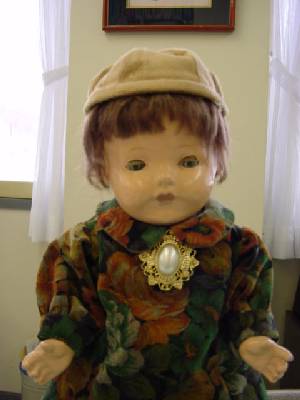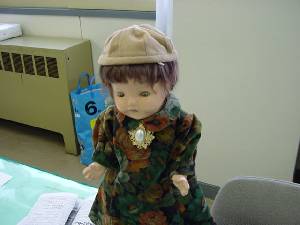

Introducing Our Blue-eyed Doll


Name Betty Jane
|
The Blue-eyed Dolls came to Japan on March 3, 1927. Crossing the wide Pacific Ocean as goodwill messengers of peace, they were received by the Japanese government and then were given to elementary schools throughout Japan. At a morning assembly of Bikuni Elementary School's teachers and students, the principal at that time, Saburo Igarashi, expressed his feelings of gratitude and told the whole story of how this doll was given to our school. It was impressive how he concluded the story, "Let's resolve anew to aspire to peace and friendship." The arrival of the "Blue-eyed Dolls" was one of the heart-warming events that highlighted the beginning years of the Showa Period (1926 - 1989). On May 27, the schoolchildren and teachers, and also parents, brothers, and sisters, participated in a welcoming ceremony. Dolls of the girl students were brought to the school, and they were arranged around the Blue-eyed Doll Betty Jane on the decorated stage. After an inspirational greeting that delighted the participants, words of welcome were spoken by school representatives. When Betty Jane bent her upper body forward and bowed, she cried out, "maa-maa." The assembly participants could not understand the meaning of this. (Author's note: simply the meaning of "mama"?) They thought perhaps it was a greeting. In America, they were concerned about Betty Jane's hard life in the faraway country of Japan, so they gave her a black mantle to wear and also a blouse, socks, and night clothes. During the long journey, her heart must have been beating fast as she carried a passport in her perfectly suited clothes. In those days, the children's
song "The Blue-eyed Doll," which depicts this doll (and her sisters), was
a favorite song of children. At Bikuni Elementary School, together with the doll is kept a book entitled "Blue-eyed Doll Commemorative Book," which contains expressions of gratitude written by students. School children created this web page based on some old reference documents, which were handwritten with an ink brush in cursive script. |
Special thanks to
Bikuni Elementary
School for permission to publish this web page.
This is an English translation of a Japanese
web page (link no longer available).
Return
to American Blue-eyed Dolls - Individual Dolls